Picking winners, part 2

A fortnight ago I discussed the preference colonies show for heavy eggs – or more accurately for larvae reared from heavy eggs – when producing queens under the emergency response.
Why might this be interesting?
The longevity of the queen and the absolute dependence the colony has on her quality means that the choice of larvae they rear new queens from is of fundamental importance.
These are the larvae that develop to produce queens with the traits that benefit the colony – in fecundity, disease resistance and a range of other characteristics.
It cannot be random.
If they make the right choice the colony will flourish, swarm and their genes will be perpetuated.
That is a significant evolutionary selective pressure. Its application over the 90 million years or so since the evolution of eusociality has resulted in the honey bees we have today.
Now, these traits favoured by the bees might not all benefit our beekeeping, but some of them should. Longevity, fecundity and disease resistance are likely to be evolutionarily favourable traits, and will also be useful for beekeepers.
Defensiveness and swarminess … er, not so much 😉 .
But the bees have little time to select the best larvae. They have 6 days from the day the egg is laid until a larva is too old {{1}} to reliably develop into a queen.
In practice they select very young larvae (or even 3 day old eggs) so ensuring the resulting queen is fed for the maximum time with royal jelly, thereby producing a larger queen with more ovarioles.
So what do the bees choose?
Given the choice, which larvae are selected by the bees to rear new queens?
Artificial experiments and nepotism
The ‘heavy eggs’ experiment I discussed a fortnight ago was primarily designed to study kin selection and nepotism in honey bees. The study was conducted over a decade ago {{2}}, but wasn’t published until 2021, though the results were known before then {{3}}.
If you remember, nepotism in honey bees is a nice idea; particular patrilines of workers (fathered by the same drone) should favour larvae of the same patriline. However, there have been no convincing studies that actually support this, and there are compelling theoretical arguments why nepotism could actually be detrimental to the colony.
Parts of the study I’m going to discuss this week were also designed to test for nepotism. I’m going to ignore these {{4}} and instead focus on some more interesting results that I think have practical relevance for beekeeping.
In addition, the study this week uses methods that are more typical of those used by beekeepers and that avoid the artificiality of rearing larvae in vitro before reintroducing them to a queenless colony.
In this regard I’d argue that they more closely resemble what’s happening in a colony rearing emergency queens. Furthermore, they should be easier for beekeepers to understand, and to repeat … not for experimental purposes, but when rearing queens.
Sagili et al., (2018)
The majority of the studies I’m going to discuss are from Sagili et al., (2018). The title ’Honey bees consider larval nutritional status rather than genetic relatedness when selecting larvae for emergency queen rearing’ neatly summaries their conclusions, but some of the detail is worth discussing in a bit more detail.
It’s always interesting to know what goes on in the hive.
During inspections we see frames of brood – capped and open cells. Other than the larvae getting bigger as they get older they all look much of a muchness … but they’re not.
All larvae are equal, but some are more equal than others 😉 .
Hungry mouths
The queen lays an egg in an empty cell. Other than the egg, the cell remains empty for 3 days when the egg hatches to release the larva. Without prompt and regular feeding the larva will starve or suffer setbacks in development.
For this reason the nurse bees make frequent visits to the occupied cells to determine their content and needs.
Is it an egg or a larva?
Is it hungry?
And these visits continue during the 5 days of larval development.
How many visits do they make, how often is a larva fed, and are all larvae treated equally?
Sagili and colleagues used observation hives and video cameras to record nurse bees visiting cells containing larvae of precise ages {{5}}. They recorded visits over 4 hours to 2 day old larvae, and one hour observations of 5 day old larvae.
In four separate hives, 4-8% of the young (2 day old) larvae did not receive a visit from a nurse bee during the 4 hour period they were filmed.
Of the 5 day old larvae, again ~10% didn’t receive a visit during the observation period and, of those fed, the longest interval between feeds was ~36 minutes. However, over one hour, the older larvae that were being fed were visited very regularly; the median interval between feeds was a little under 4 minutes and they were fed for a total of ~7 minutes over one hour.
Clearly some larvae, for whatever reason, get little or no attention for extended periods, whereas those that are visited, are fed very frequently.
Nutritionally deprived and non-deprived larvae
Larvae that are infrequently visited are likely to be nutritionally deprived … or, using the technical jargon beloved of beekeepers and scientists alike, hungry {{6}}.
Do nurse bees respond differently to nutritionally deprived and non-deprived larvae?
Which are visited first and fed first?
The scientists caged the queen on a frame and allowed her to lay eggs for 24 hours. They then removed the queen (caging her elsewhere in the hive) and waited for the eggs to hatch. 24 hours later the larvae were caged under either 13 mm mesh or 3 mm mesh. Workers can access the larvae through the 13 mm mesh, but cannot get through 3 mm mesh. Cages were left in place for four hours to create two populations of larvae on the same frame; nutritionally deprived and non-deprived.
They then again used video recording of randomly selected larvae to record and quantify the attention and feed visits they received.
The purpose of this part of the study was to determine whether the nurse bees could discriminate between larvae that were nutritionally deprived and those that were not.
And they could …
Deprived larvae were visited (inspected) sooner, the black bars in the graph above, and fed earlier. You can just about determine this from the graph; the stats are more convincing (but less comprehensible 😉 ).
In addition, deprived larvae received more frequent inspections, more frequent feeds and were fed for longer.
Acceptance of larvae for queen rearing
A colony rendered suddenly queenless will attempt to rear a replacement under what is called the emergency response. Suitable young larvae are selected, fed a diet rich in royal jelly and the cell is reshaped to be orientated vertically.
This vertical orientation is a major inducement for the workers to continue to feed the developing larva with royal jelly (She et al., 2011). This is exploited in queen rearing techniques that involve the grafting of young larvae into wax or plastic cups which are then placed, open end down, in a queenless colony.
Sagili et al., investigated whether nutritionally deprived and non-deprived larvae were favoured when queens were reared under the emergency response.
Interestingly, they did so using larvae in natural comb and following grafting into plastic queen cups.
Which were favoured for queen rearing? Grafted or natural, nutritionally deprived or non-deprived?
In both instances the larvae were presented to a queenless and broodless colony, using 6 recipient colonies in each case.
In the case of grafting, 12 of each type of larvae were presented on a cell bar frame. When transferring comb (prepared as described before using caged larvae) the entire frame was introduced.
The recipient colony did not discriminate between the nutritionally deprived and non-deprived larvae when they were grafted, but they showed a marked preference for the non-deprived larvae in natural comb.
In addition, they reared significantly more queens from grafted larvae than they did from larvae in comb.
All larvae are equal, but some are more equal than others …
Since I’m enthusiastic about queen rearing, this last set of experiments was by far the most interesting part of the study.
There are two results that are particularly striking.
Firstly, more queens were reared from grafted larvae than were reared following the transfer of a frame of larvae. The difference was significant, with almost twice as many queens being produced following grafting. It’s also worth noting that the bees only had 24 grafted larvae to choose from, compared to a much larger number of larvae on the transferred natural comb.
Secondly, the workers showed no preference between nutritionally deprived and non-deprived grafted larvae, but showed a strong preference for the well-fed larvae in natural comb.
So, what do these results mean?
Let’s have a quick recap:
- developing larvae receive different amounts of ‘attention’ from nurse bees
- about 10% of developing larvae received no (or only a limited number of) visits during an extended observation period. The presumption is that these larvae are likely to be nutritionally deprived (though this was not demonstrated)
- nurse bees can readily distinguish between nutritionally deprived and non-deprived larvae; the former receive earlier inspections, are fed sooner and more frequently
- when rearing emergency queens, workers preferentially select larvae in natural comb that are not nutritionally deprived. In contrast, they make no distinction between nutritionally deprived and non-deprived grafted larvae
We know from numerous studies that high quality queens must be well fed during larval development. The best queens are produced from very young larvae (or even 3 day old eggs) that are then fed for an extended period with copious amounts of royal jelly in a strong hive full of nurse bees.
Queens produced under these conditions are larger and have more ovarioles, so should lay more eggs for longer.
It makes sense that nurse bees can distinguish between ‘hungry’ and replete larvae … the former need feeding or they won’t develop properly. The former may already have been held back developmentally … not an ideal start for a new queen.
Since nurse bees can determine the nutritional status of very young larvae, logic would dictate that they would select those that are not nutritionally deprived to rear new queens from.
After all, the future of the colony, and any resulting swarms will depend on it.
So, why don’t they make a similar distinction when presented with grafted larvae?
Selection vs. maintenance of larvae for queen rearing
The key difference between the grafted larvae and those in natural comb was the orientation of the ‘cells’ in which the larvae were presented to the queenless and broodless colony.
Grafted larvae were presented in a vertically orientated plastic queen cup, whereas the cells in natural comb are horizontal {{7}}.
The interpretation is that larvae in vertically orientated cells are not selected by the nurse bees, but are instead just maintained as developing queens.
In contrast, larvae in horizontal(ish) natural comb are selected as the starting material for new queens, and the resulting reshaping of the comb to form the queen cell leads to their maintenance as developing queens.
Significance for beekeeping and queen rearing
The increased number of queens reared from grafted larvae probably reflects this ‘maintenance’ response being triggered in the nurse bees. ’Any’ larva presented in a suitably orientated cell must have been preselected as suitable … so the bees feed them up with royal jelly.
The nurse bees don’t know that these grafted larvae were selected by the beekeeper, not on the basis of them being nutritionally replete, but more likely because they were visible, about the right size, and in an accessible part of the comb.
But … think back to the first experiment. This suggested that ~10% of all larvae are nutritionally deprived because they have received, at best, infrequent visits over the last few hours. If the beekeeper hadn’t picked them during grafting, it’s unlikely the bees would have selected them as being suitable for producing queens.
Are 10% of grafted queens sub-optimal? Remember, the differences may be subtle.
The other point I found interesting is that the bees reared fewer queens in natural comb than from grafted larvae.
Why?
One possibility is that the reshaping of the comb is a physical limitation and restricts queen production. Perhaps this is why so many are at the edge of combs? {{8}}
Another is that the bees only rear ’enough’ queens for their needs, but that they can only determine what ‘enough’ is using larvae in natural comb.
Whilst these are certainly possible I think there’s an intriguing alternative … only a small proportion, even of well fed larvae, are considered suitable by the colony for queen rearing and so selected by the nurse bees.
Yes, the bees favour larvae that are not nutritionally deprived, but perhaps there are additional characteristics that are also desirable (and that vary between larvae).
Quantity and quality
Grafting larvae is a well established method of producing large numbers of queens. If the donor colony is good quality there’s every reason to expect that the resulting queens will be good.
Most, if not all, commercially reared queens come from grafted larvae (where quantity is paramount and quality might be a secondary concern) … probably hundreds of thousands of queens a year are produced like this. It’s the method I’ve used for many years.
But this paper raises two or three interesting ideas:
- about 10% of larvae selected at random for grafting are likely to be nutritionally deprived and so would not have been chosen by the nurse bees. The presumption is that these will produce sub-standard queens.
- nurse bees might be a lot more selective in the larvae they choose for emergency queens, only favouring a subset of even those not nutritionally deprived.
- queen rearing methods that present larvae in natural comb might produce fewer queens but those queens may have the desirable characteristics selected by the bees (potentially resulting in better quality but a smaller quantity).
If this last point is correct, it’s worth noting that queen rearing methods – like the Hopkins method – that use larvae in frames placed horizontally over the colony {{9}}, may trigger the queen maintenance response rather than allowing the selection of larvae by the nurse bees.
It would be very interesting to determine whether the bees would discriminate between nutritionally deprived and non-deprived larvae presented on a horizontal frame.
Two final thoughts;
- Grafting works well, but that doesn’t mean it’s the best way to produce top-quality queens.
- The desirable characteristics nurse bees favour (for colony survival and reproduction) may not be beneficial for beekeeping.
But I’d be surprised if they weren’t 🙂
Note
I’ve not had a chance to discuss it, but Free et al., (1989) previously demonstrated that nutritionally deprived larvae received more attention from nurse bees. I’ll deal with how the workers detect the nutritional status of larvae in the future.
References
Free, J.B., Ferguson, A.W., and Simpkins, J.R. (1989) The Effect of Different Periods of Brood Isolation on Subsequent Brood-Cell Visits by Worker Honeybees (Apis Mellifera L.). Journal of Apicultural Research 28: 22–25 https://doi.org/10.1080/00218839.1989.11100815. Accessed November 22, 2022.
Sagili, R.R., Metz, B.N., Lucas, H.M., Chakrabarti, P., and Breece, C.R. (2018) Honey bees consider larval nutritional status rather than genetic relatedness when selecting larvae for emergency queen rearing. Sci Rep 8: 7679 https://www.nature.com/articles/s41598-018-25976-7. Accessed November 21, 2022.
Shi, Y.Y., Huang, Z.Y., Zeng, Z.J., Wang, Z.L., Wu, X.B., and Yan, W.Y. (2011) Diet and Cell Size Both Affect Queen-Worker Differentiation through DNA Methylation in Honey Bees (Apis mellifera, Apidae). PLOS ONE 6: e18808 https://journals.plos.org/plosone/article?id=10.1371/journal.pone.0018808. Accessed November 22, 2022.
{{1}}: Technically … no longer totipotent.
{{2}}: When lots of stuff on kin selection were being done.
{{3}}: And are cited in the 2018 paper I’m covering here.
{{4}}: As the authors also found no evidence for nepotism.
{{5}}: Obtained by caging the queen on a drawn comb for a known period.
{{6}}: Actually, to be pedantic, we don’t know whether the larvae are hungry or not … we just know if they have been fed. Hungry refers to a sensation, and we’ve no idea what these larvae were feeling.
{{7}}: Actually, they’re at 13° to the horizontal … though not for the reasons you probably think. More on this another time.
{{8}}: There are other reasons, but I’ve run out of space.
{{9}}: So the cells are vertical.
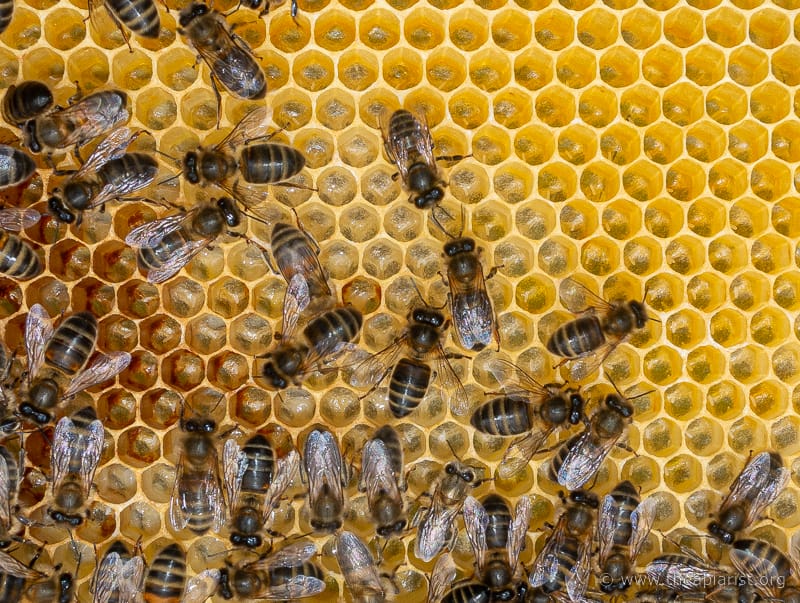
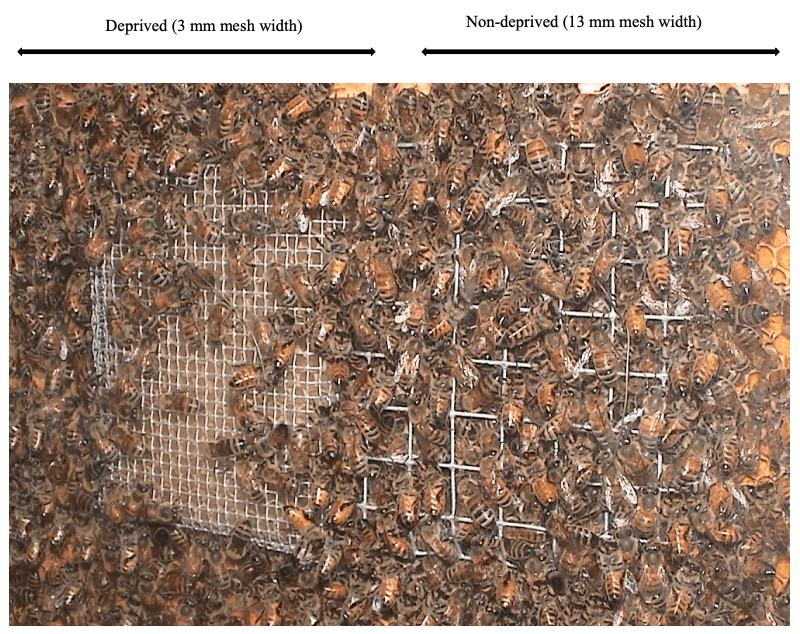
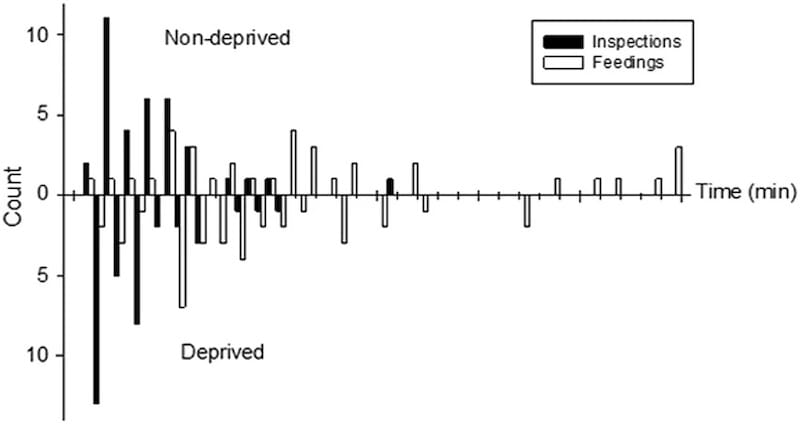
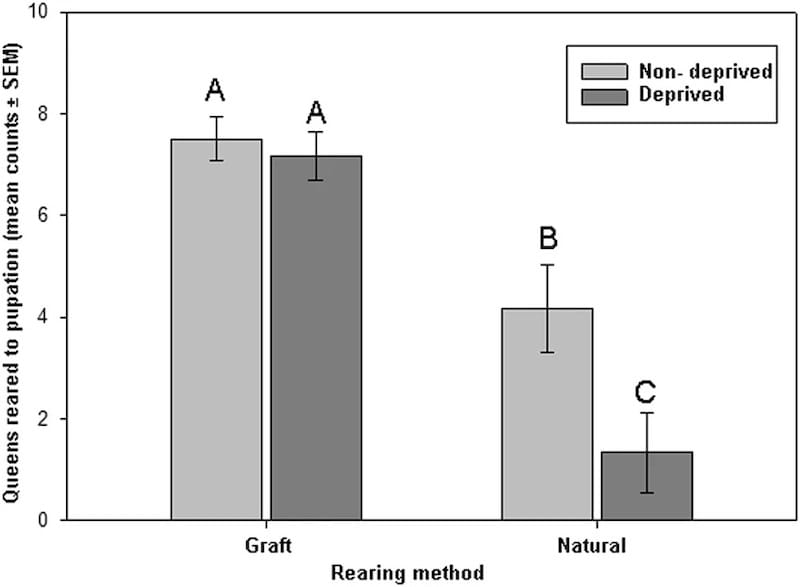
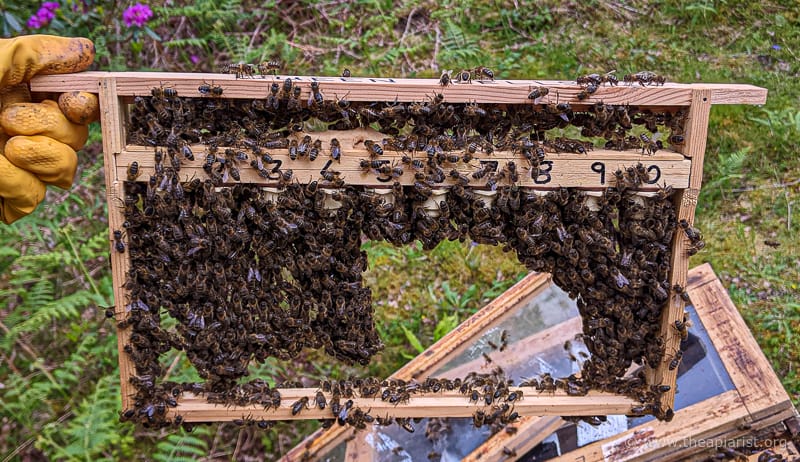
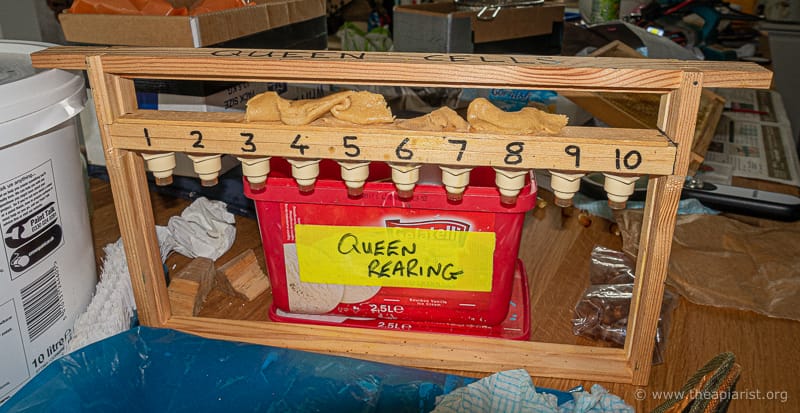
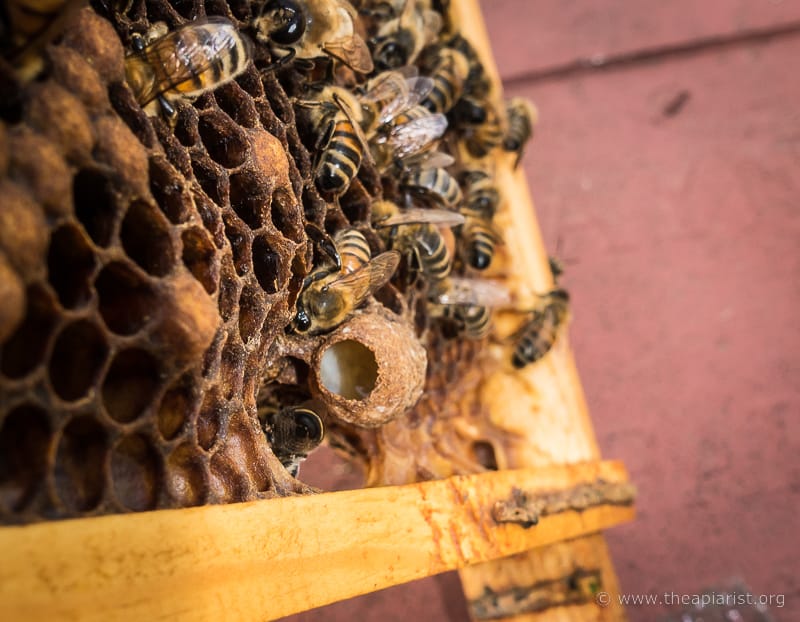
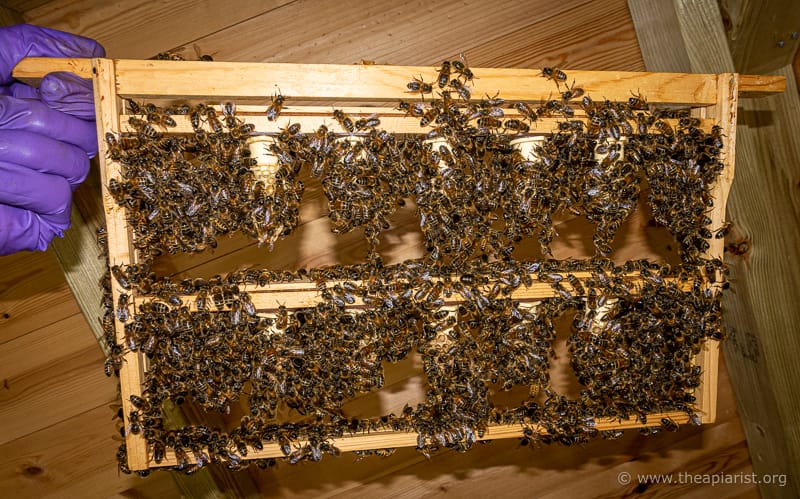
Join the discussion ...